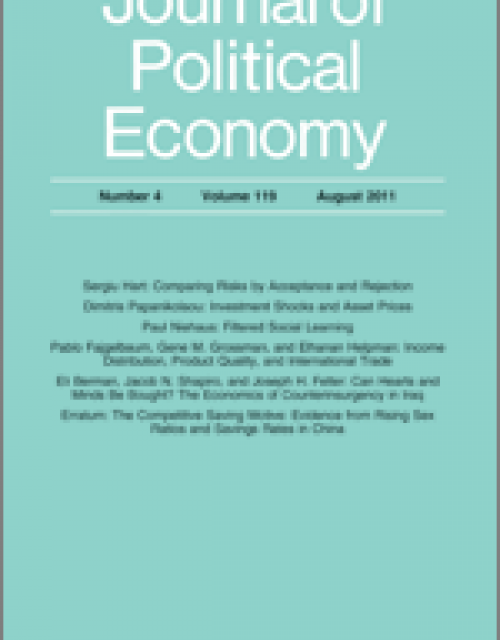Publication records
Subject(s)
Ethics and social responsibility
Keyword(s)
Production ethics, international ethics, transparency, workplace exploitation, supply chain sustainability, social responsibility
This is an abridged version of the case Axel Springer and the quest for the boundaries of corporate responsibility. The case deals with the quest for boundaries of corporates’ social and environmental responsibility. It poses the question where the responsibility of a company might start or end in a given context and once the company has been able to assess the extent to which it holds itself responsible, what action it ought to take in this regard. In the case of Axel Springer the question is focused on the aspect how much responsibility the company might have for its supply chain: how far and how deep down the supply chain does or should responsibility of a corporation reach? On what facts does this responsibility depend? The publishing house Axel Springer AG serves as good example as it wonders about the scope of their responsibility: After making the strategic decision to move aggressively into the field of digital news and media, the company wonders about their responsibility for digital devices, in particular with respect to conflict minerals that are extracted for the production and use of such electronic devices under highly problematic conditions.
The case draws attention to a rather ambiguous, quite complex, and intertwined sustainability issue. It requires students to think laterally about anticipated and potential risks, about scopes and the extent of responsibility. The case can be well-introduced at a later and more advanced stage of the term as it deals with the concerns of an only indirectly involved media and publishing house that can either neglect or take up the challenge of dealing with conflict minerals. Students preferably know concepts of risk management and corporate responsibility or are acquainted with cases focusing on formulating, implementing, or articulating corporate responsibility before dealing with the question of at what stage and with what tier of the supply chain could or should corporate responsibility end.
| buy now | buy now |
Subject(s)
Economics, politics and business environment; Ethics and social responsibility
Keyword(s)
Negotiation, distributive negotiation, integrative negotiation, European cross-border infrastructure projects, implications on management of permitting and communication, different approaches to negotiations
Secondary Title
Project management
Edition
9th ed.,
Pages
108–110
ISBN
978-1-118-94583-4
Subject(s)
Information technology and systems; Marketing
Keyword(s)
ROI, CRM, benefits realization, performance improvement, social media, big data
Marketing practice is increasingly shaped through the application of new technology, including customer relationship marketing (CRM) software, social media, analytics and search, with organisations investing heavily in these technologies. Yet, surprisingly, research by marketing scholars continues to question the profitability of IT-led marketing initiatives. If this is true, why do companies continue to make such investments? To explore this question, we examined research that has looked at the return on investments in IT-led marketing change. Analysing the findings of leading studies of the impact of CRM spend on financial and market performance, we suggest that marketing scholars make untested assumptions as to how expected payoffs are realized and thus generate incommensurate conclusions. Moreover, we found that marketing scholars adopt a very limited epistemology that is unsuited to the nature of the phenomenon being studied. For comparison, we explore how similar phenomena are studied by the information systems discipline. We conclude with implications for both marketing practice and research.
With permission of Emerald
Volume
49
Journal Pages
561–595
Subject(s)
Economics, politics and business environment
Secondary Title
Handbuch Sicherheitsgefahren
Pages
229–238
ISBN
978-3-658-02752-0
Subject(s)
Marketing
© 2014 Product Development & Management Association
Volume
32
Journal Pages
424–440
Subject(s)
Economics, politics and business environment
Keyword(s)
Social interactions, identification, incomplete information games
JEL Code(s)
C21, C23, C31, C35, C72, Z13
This paper provides a systematic analysis of identification in linear social interactions models. This is both a theoretical and an econometric exercise as the analysis is linked to a rigorously delineated model of interdependent decisions. We develop an incomplete information game that describes individual choices in the presence of social interactions. The equilibrium strategy profiles are linear. Standard models in the empirical social interactions literature are shown to be exact or approximate special cases of our general framework, which in turn provides a basis for understanding the microeconomic foundations of those models. We consider identification of both endogenous (peer) and contextual social effects under alternative assumptions on a priori information about network structure available to an analyst, and contrast the informational content of individual-level and aggregated data. Finally, we discuss potential ramifications for identification of endogenous group selection and differences between the information sets of analysts and agents.
With permission of the University of Chicago Press
Volume
123
Journal Pages
444–496
Subject(s)
Marketing
Keyword(s)
Goals, product evaluation, positive mood
Negotiating the pursuit of multiple goals often requires making difficult trade-offs between goals. In these situations, consumers can benefit from using products that help them pursue several goals at the same time. But do consumers always prefer these multipurpose products? We propose that consumers’ incidental mood state alters perceptions of products in a multiple-goals context. Four studies demonstrate that being in a positive mood amplifies perceptions of differences between multiple conflicting goals. As a consequence, consumers are less likely to evaluate multipurpose products as being able to serve multiple distinct goals simultaneously. We conclude by discussing implications of these findings for marketers of multipurpose products.
With permission of Elsevier
Volume
25
Journal Pages
296–303
Subject(s)
Entrepreneurship; Technology, R&D management
Keyword(s)
Patent indicators, patent system, product commercialization, pharmaceutical industry, drug development
Patent-based measures are frequently used as indicators in empirical research on innovation and technological change. Currently, there is little evidence as to what extent patent-based indicators relate to product market outcomes. Using a unique dataset that links outcomes from product commercialization in the pharmaceutical industry with detailed patent data, we relate patent-based indicators that capture either an invention’s value or the uncertainty surrounding the patenting process to the outcomes of the product development process. Our findings suggest that the speed of commercialization increases with value but reduces with uncertainty. Using a variety of alternative indicators we derive implications for the use and the proper interpretation of individual measures. Moreover, our study has broader implications as it highlights the detrimental effect of uncertainty on the speed of innovation.
View all ESMT Working Papers in the ESMT Working Paper Series here. ESMT Working Papers are also available via SSRN, RePEc, EconStor, and the German National Library (DNB).
Pages
44
ISSN (Print)
1866–3494
Subject(s)
Marketing
Keyword(s)
Banking, finance, customer service, client centricity, private wealth management, investment banking, customer satisfaction
The financial market crisis has brought the very business models of many banks into question. What lessons should banks take from these events? What consequences will the industry have to face when dealing with clients? These questions are at the center of this book, with contributions from renowned experts and examples from theory and practice. Client commitment – the pursuit of pure customer focus – has become a success factor in many areas of the banking industry. This book sheds light on the theoretical aspects of client commitment and shows how its various facets are being put into practice.
Pages
264
ISBN
978-3-86774-453-9
Subject(s)
Ethics and social responsibility; Marketing
Keyword(s)
Corporate social responsibility, business–nonprofit alliance, nonprofit, Company involvement, company reputation, alliance fit
We investigate the effect of increased company involvement on consumer reactions to companies and nonprofits in business–nonprofit alliances to show that consumer reactions to the two parties in such alliances can, under certain conditions, diverge from each other. Specifically, we show that increased company involvement results in more positive consumer attitudes toward companies with low (but not high) reputation, while it leads to more positive consumer attitude toward nonprofits that partner with companies with high (but not low) reputation. Furthermore, we demonstrate that these effects are independent of the perceived fit between the company and nonprofit forming the alliance. Finally, we show that when consumers elaborate on company motives, the observed effects of increased company involvement are mitigated.
© Springer Science+Business Media New York 2013. With permission of Springer
Volume
26
Journal Pages
29–42



